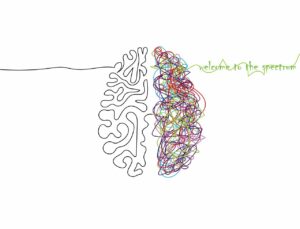Autism spectrum disorder (ASD) is a disorder that affects how people communicate, process information, interact with others, etc. People can be diagnosed with autism as early as 2 years old and up to adulthood. Historically, it was thought that only boys and men could have autism, but that is very much false. Autism is more prevalent in boys than it is in girls currently, about 4.3% of boys vs 1.1% of girls in the US, as of 2020.
As we are understanding more about what autism is and what it can look like, we are learning that more people have it than previously thought. Many people go undiagnosed until adulthood, especially women and people assigned female at birth (AFAB). Most of the current research on autism and the assessment tools are based on boys, allowing so many women and AFAB people to go undiagnosed or be misdiagnosed. Autism appears differently in women and AFAB people than it does in men and here are some of the key differences:
Less Social Difficulties
The key word here is “less”! This isn’t to say that autistic women and AFAB people don’t have social difficulties, but they often have less difficulty than autistic men. They’re more likely to be motivated to form friendships and find ways to participate in conversations. They’re also more likely to mask or hide difficulties they’re having by mimicking people around them or behaviors from TV shows. Autistic women and AFAB people generally have less difficulty communicating than men.
Common Special Interests
Women and AFAB autistic people do have special interests. Special interests are a trademark symptom of autism. The difference here is that they’re more likely to be common in other women and AFAB people, like horses, make-up, fashion, or celebrities. Or their special interests are more broad concepts, such as history or communication. This allows them to fly under the radar since neurotypical people are interested in those things too, just not to the same level of interest.
Internalized Symptoms

Internalizing symptoms is when you don’t show or hide the issues and struggles you’re having and this can happen for a variety of reasons. Women and AFAB people with autism generally internalize their symptoms or mask them to try to better fit in. This can cause them to be more likely to develop anxiety and depression as a response to internalizing/masking their symptoms. This can look like shyness, which is a more typical social behavior.
Misdiagnosis
Many autistic women and AFAB people are often misdiagnosed with social anxiety disorder, borderline personality disorder (BPD), generalized anxiety disorder, or major depressive disorder. There are overlapping symptoms of autism and these disorders and it is possible to be diagnosed with multiple disorders. Autism and BPD are often confused due to the numerous symptoms that appear similar, but have different functions to the behavior.
Here are some of the symptoms that overlap and appear similar:
- Shame
- Mood fluctuations
- Difficulty in relationships
- Poor sense of self
- Low impulse control
- Rejection sensitivity
- Increased risk of self injury and suicidality
The Key Differences
Autism
- Sensory issues: autistic women and AFAB people often have more sensory issues than men
- Emotional upset is caused often when there is unexpected change, cognitive overload, and/or sensory overload causing a meltdown or shutting down
- Difficulty maintaining relationships or having more than 1 intense friendship at a time
- Poor sense of self due to masking and feeling like you don’t know who you are since you have hidden parts of yourself
- Repetitive behavior and routines
- Special interests
BPD
- Fear of abandonment
- Persistent pattern of instability in relationships of all types, quickly moving from idealization to devaluation
- Poor sense of self due to changing things about yourself in attempts to not be potentially abandoned
- Mood changes rapidly usually lasting for hours or the rest of the day
- Stress related paranoia or severe dissociation
These are not all of the symptoms for either autism or BPD, just some of the commonalities and differences between the two disorders. If you would like to know more about BPD, please check out this blog. If you would like to know what DBT skills can be helpful in managing autism then check out this blog.
About the Author
Robyn Williams (she/her), M.A., LPC is a Licensed Professional Counselor who specializes in dialectical behavior therapy. Robyn works with teens and adults in a compassionate judgment-free manner to meet clients where they are in life. She helps her clients develop the tools they need in order to live their life worth living, and find what means most to them. Robyn believes that while therapy can be intimidating at times, it can be a conduit for personal growth. Click here to learn more about Robyn’s experience and therapeutic approach.
References
1 https://www.nimh.nih.gov/health/topics/autism-spectrum-disorders-asd
2 https://www.nimh.nih.gov/health/statistics/autism-spectrum-disorder-asd
3 https://www.uclahealth.org/news/understanding-undiagnosed-autism-adult-females


